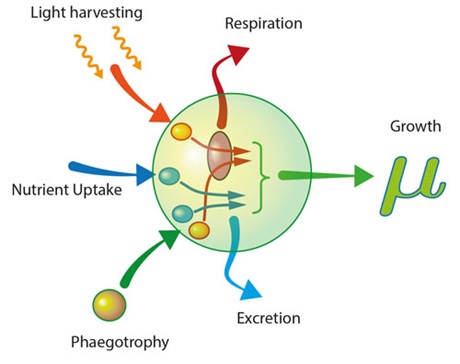All life is faced by a fundamental trade-off: how to allocate limited resources to the various tasks that allows them to grow, survive and reproduce. For unicellular organisms, these tasks include gaining energy from light, taking up mineral nutrients form their environment, capturing and digesting prey items, and constructing defences (armour, escape behaviour, toxins).
We develop a generalist model where we consider variable allocation strategies for light harvesting, nutrient uptake and phaegotrophy. This captures a wide sweep of unicellular life forms from autotrophy, to heterotrophy with mixotrophy (part plant – part animal) in between. And all in a single model description.
Fixed carbon is taken up through photosynthesis and phaegotrophy while nutrients come via direct intake or from prey, and synthesised to produce new biomass.

In each process, there is a required cost in both the construction and maintenance of appropriate machinery (chloroplasts, uptake sites, enzymes, ribosomes, mitochondria) to carry out these tasks: costs that are paid for in fixed carbon leading to respiration. Synthesised biomass has a certain C:N ratio and any excess is excreted.
Size plays a central role in that affinity scales differently for the acquisition of the various resources. Light harvesting for instance scales with the surface area of the cell, nutrient uptake with its linear dimension while phaegotrophy with the cell volume. Optimal allocation thus varies not only with environmental conditions (ambient light and nutrients, prey availability) but also size.